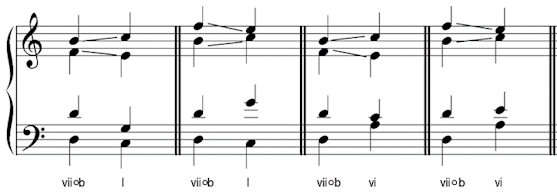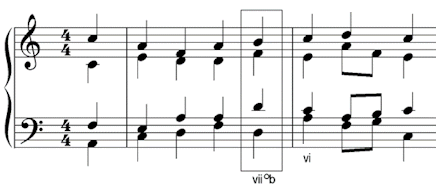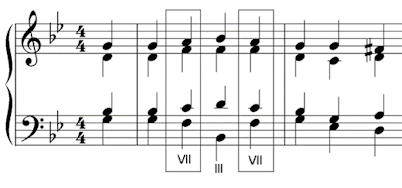Chord vii° (Diminished)
The chord built up from the 7th degree of the scale, or leading note, is called the leading note triad, or chord vii° (“seven diminished”).
The leading note triad is made up of the 7th, 2nd and 4th notes of the major or minor scale.
Chord vii° in C major contains the notes B, D and F.

We usually use the notes from the harmonic minor scale to build the leading note chord. Chord vii° in A minor contains the notes G#, B and D.

The leading note triad in both major and minor keys is a diminished triad. The interval between the lowest note and the middle note is a minor third, but the interval between the lowest note and the top note is a diminished 5th. Diminished chords are written with a small circle °, and in lower case letters.
Because vii° is a dissonant chord, there are some special considerations to keep in mind when using it.
- Chord vii° normally moves only to the tonic or (less often) submediant chords.
- Chord vii° is most often seen in first inversion. Sometimes it is seen in root position, but almost never in 2nd inversion.
- In 4-part harmony, it is the 3rd of the triad which is normally doubled (not the root or 5th).
- The dissonant interval within the chord must be handled correctly when writing harmony.
Notice how the leading note (B) in chord vii° moves upwards by step to the tonic (C), and the subdominant note (F) in vii° moves downwards by step to the mediant (E). Together, the leading note and subdominant note create a dissonant harmonic interval of either an augmented 4th or a diminished 5th, and this interval needs to be handled correctly.

Here is an example of vii°b moving to chord vi. This extract is from the hymn “All Praise and Thanks to God most High”.

Chord VII (Major)
The triad built from the 7th degree of the descending melodic minor scale is a major chord.
This chord is sometimes called “flat VII”, because the 7th degree of the minor scale is not raised up by semitone (as it is in the harmonic minor scale). It can be written as VII or ♭VII. It is not usually called the “leading note” chord, because the term “leading note” refers to the raised 7th degree of the scale.
The flat VII chord in A minor contains the notes G, B and D.

This chord is the same as the dominant chord in the relative major key. VII tends to be used when moving to or from chord III (from the melodic minor scale).
This example of VII moves from and to chord III. It is from an Anglican hymn “Today O Lord a Holier Work”. The key is G minor, and chord VII is F major.

Chord VII does not normally move to chord I (or i) in classical music, but this progression is quite common in pop and folk music.
